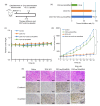Inhibition of chemotherapy-related breast tumor EMT by application of redox-sensitive siRNA delivery system CSO-ss-SA/siRNA along with doxorubicin treatment
- PMID: 32133799
- PMCID: PMC7086009
- DOI: 10.1631/jzus.B1900468
Inhibition of chemotherapy-related breast tumor EMT by application of redox-sensitive siRNA delivery system CSO-ss-SA/siRNA along with doxorubicin treatment
Erratum in
-
Erratum to: Inhibition of chemotherapy-related breast tumor EMT by application of redox-sensitive siRNA delivery system CSO-ss-SA/siRNA along with doxorubicin treatment.J Zhejiang Univ Sci B. 2022 Feb 15;23(2):171-172. doi: 10.1631/jzus.B19e0468. J Zhejiang Univ Sci B. 2022. PMID: 35187891 Free PMC article. English.
Abstract
Metastasis is one of the main reasons causing death in cancer patients. It was reported that chemotherapy might induce metastasis. In order to uncover the mechanism of chemotherapy-induced metastasis and find solutions to inhibit treatment-induced metastasis, the relationship between epithelial-mesenchymal transition (EMT) and doxorubicin (DOX) treatment was investigated and a redox-sensitive small interfering RNA (siRNA) delivery system was designed. DOX-related reactive oxygen species (ROS) were found to be responsible for the invasiveness of tumor cells in vitro, causing enhanced EMT and cytoskeleton reconstruction regulated by Ras-related C3 botulinum toxin substrate 1 (RAC1). In order to decrease RAC1, a redox-sensitive glycolipid drug delivery system (chitosan-ss-stearylamine conjugate (CSO-ss-SA)) was designed to carry siRNA, forming a gene delivery system (CSO-ss-SA/siRNA) downregulating RAC1. CSO-ss-SA/siRNA exhibited an enhanced redox sensitivity compared to nonresponsive complexes in 10 mmol/L glutathione (GSH) and showed a significant safety. CSO-ss-SA/siRNA could effectively transmit siRNA into tumor cells, reducing the expression of RAC1 protein by 38.2% and decreasing the number of tumor-induced invasion cells by 42.5%. When combined with DOX, CSO-ss-SA/siRNA remarkably inhibited the chemotherapy-induced EMT in vivo and enhanced therapeutic efficiency. The present study indicates that RAC1 protein is a key regulator of chemotherapy-induced EMT and CSO-ss-SA/siRNA silencing RAC1 could efficiently decrease the tumor metastasis risk after chemotherapy.
Keywords: Doxorubicin; Tumor metastasis; Ras-related C3 botulinum toxin substrate 1 (RAC1); Epithelial-mesenchymal transition (EMT); Chitosan micelles; Small interfering RNA (siRNA).
Conflict of interest statement
All institutional and national guidelines for the care and use of laboratory animals were followed.
Figures








Similar articles
-
Erratum to: Inhibition of chemotherapy-related breast tumor EMT by application of redox-sensitive siRNA delivery system CSO-ss-SA/siRNA along with doxorubicin treatment.J Zhejiang Univ Sci B. 2022 Feb 15;23(2):171-172. doi: 10.1631/jzus.B19e0468. J Zhejiang Univ Sci B. 2022. PMID: 35187891 Free PMC article. English.
-
Sequential therapy with redox-responsive glucolipid nanocarrier separately delivering siRNA and doxorubicin to overcome multidrug resistance.Int J Pharm. 2017 Dec 20;534(1-2):368-377. doi: 10.1016/j.ijpharm.2017.10.036. Epub 2017 Oct 16. Int J Pharm. 2017. PMID: 29051118
-
Redox-responsive polymer-drug conjugates based on doxorubicin and chitosan oligosaccharide-g-stearic acid for cancer therapy.Mol Pharm. 2015 Apr 6;12(4):1193-202. doi: 10.1021/mp500710x. Epub 2015 Mar 16. Mol Pharm. 2015. PMID: 25751168
-
The involvement of epithelial-to-mesenchymal transition in doxorubicin resistance: Possible molecular targets.Eur J Pharmacol. 2021 Oct 5;908:174344. doi: 10.1016/j.ejphar.2021.174344. Epub 2021 Jul 13. Eur J Pharmacol. 2021. PMID: 34270987 Review.
-
Effects of NaV1.5 and Rac1 on the Epithelial-Mesenchymal Transition in Breast Cancer.Cell Biochem Biophys. 2025 Jun;83(2):1483-1494. doi: 10.1007/s12013-024-01625-x. Epub 2024 Dec 14. Cell Biochem Biophys. 2025. PMID: 39673684 Free PMC article. Review.
Cited by
-
Hirudo extract ameliorates proliferative vitreoretinopathy by promoting autophagy and attenuating the THBS2/PI3K/Akt pathway.Sci Rep. 2025 Jan 8;15(1):1287. doi: 10.1038/s41598-025-85882-7. Sci Rep. 2025. PMID: 39779937 Free PMC article.
-
Progress in Natural Compounds/siRNA Co-delivery Employing Nanovehicles for Cancer Therapy.ACS Comb Sci. 2020 Dec 14;22(12):669-700. doi: 10.1021/acscombsci.0c00099. Epub 2020 Oct 23. ACS Comb Sci. 2020. PMID: 33095554 Free PMC article. Review.
-
Resveratrol and Its Analogs: Potent Agents to Reverse Epithelial-to-Mesenchymal Transition in Tumors.Front Oncol. 2021 Apr 16;11:644134. doi: 10.3389/fonc.2021.644134. eCollection 2021. Front Oncol. 2021. PMID: 33937049 Free PMC article. Review.
-
A Comprehensive Review of Small Interfering RNAs (siRNAs): Mechanism, Therapeutic Targets, and Delivery Strategies for Cancer Therapy.Int J Nanomedicine. 2023 Dec 13;18:7605-7635. doi: 10.2147/IJN.S436038. eCollection 2023. Int J Nanomedicine. 2023. PMID: 38106451 Free PMC article. Review.
-
Cucurbitacin B inhibits TGF-β1-induced epithelial-mesenchymal transition (EMT) in NSCLC through regulating ROS and PI3K/Akt/mTOR pathways.Chin Med. 2022 Feb 19;17(1):24. doi: 10.1186/s13020-022-00581-z. Chin Med. 2022. PMID: 35183200 Free PMC article.
References
MeSH terms
Substances
LinkOut - more resources
Full Text Sources
Medical
Research Materials
Miscellaneous

